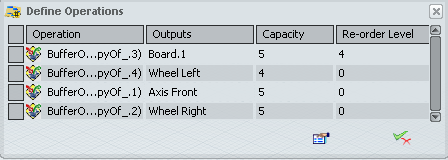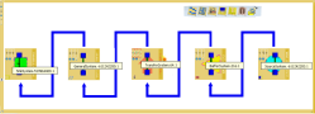About Systems | |||||||||
|
| ||||||||
System Overview
- General System: Click
 in the balloon toolbar to create a General
system.
in the balloon toolbar to create a General
system. See About Systems
- Transformation System: Click
 in the balloon toolbar to create a Transformation
system.
in the balloon toolbar to create a Transformation
system.It is used to model transformation of product(s).
- Transfer System: Click
 in the balloon toolbar to create a Transfer
system.
in the balloon toolbar to create a Transfer
system.It is used to model transportation of products between systems. Transfer operations for a product is defined by associating the corresponding provide process to a transfer system. The product spends the specified time on the system before it is routed to the downstream systems. Similar to Buffer systems, Transfer system have product capacity.
- Buffer System: Click
 in the balloon toolbar to create a Buffer system.
in the balloon toolbar to create a Buffer system.It is used to model storing of products. Attributes like capacity, reordering rules, and routing order can be defined on this system.
- Capacity: Capacity is the maximum number of products that can be stored in the system at any time.
- Reorder Level: Reorder level is number of products which trigger the request for products from upstream systems. In other words the Buffer system does not request for more products when the number of products in the system are more than the reorder level.
- Routing Order: Routing order defines the order in which products are routed out of the system. The two common types of routing orders are First In First Out (FIFO) and Last In First Out (LIFO).
- Source System: Click
 in the balloon toolbar to create a Source system.
in the balloon toolbar to create a Source system.It is used to model arrival of products into the production system. Properties like arrival mode and arrival type can be defined on this system.
- Sink System: Click
 in the balloon toolbar to create a Sink system.
in the balloon toolbar to create a Sink system.It is used to model dispatching of products from the production system processed by the upstream systems.
- Insert an Existing System: Click
 in the balloon toolbar to insert an existing system into your system structure. See Inserting an Existing System
in the balloon toolbar to insert an existing system into your system structure. See Inserting an Existing System
![]()
Create System Process Scope
Assign Create System Process Scope
![]() between any General system and assemble process. If the scope is not assigned to the root process, the warning message appears.
between any General system and assemble process. If the scope is not assigned to the root process, the warning message appears.
![]()
Define Operations
Right-click a system and select
Define Operations from the contextual menu.
The Define Operations
dialog box comes.
Note: For more information on how to define operations, see Defining Operations and System Parameters in General, Transfer, Buffer, Source, and Sink systems.
![]()
Edit System Properties
Right-click a system in the Live System Editor and select Properties to edit the reference, instance, configuration and effectivity attributes of a system.
Note: For more information, see Edit System Properties.
![]()
Delete a System
Right-click a system and select Delete from the contextual menu.
Note: For more information, see Delete a System.
![]()
Product Flow Links
You can create the product flow links between two systems in the Live System Editor.
Note: For more information, see Defining Product Flow and Flow Behavior.
![]()
Drag and Drop
Drag and drop processes from the Live Process Editor to assign them to systems in the Live System Editor. By doing this, you may create operations on the target systems.
Note: For more information, see Assign/Unassign Processes Using Live Process Editor.
![]()
Switch between Different Frames
You can switch the lower frame of the Live System Editor to the PPR Context.
Note: For more information, see Switch between Different Frames.
![]()
F5 Key
Press F5 key, to list information about the system's assigned parts, processes, operations, and fasteners.
Note: For more information, see Show Assigned Data Using the F5 List.
